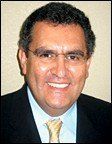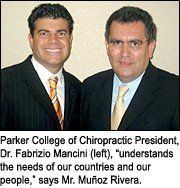Some doctors thrive in a personality-based clinic and have a loyal following no matter what services or equipment they offer, but for most chiropractic offices who are trying to grow and expand, new equipment purchases help us stay relevant and continue to service our client base in the best, most up-to-date manner possible. So, regarding equipment purchasing: should you lease, get a bank loan, or pay cash?
A Lesson in International Chiropractic
With an official regulatory body, a national association and a chiropractic degree program at a public university, Mexico boasts an organized chiropractic profession, certainly by international standards. Recently, Mexico Secretary of Education, Lic. Isidro Muñoz Rivera, discussed the growth of chiropractic education and practice in his home country, including details on an ongoing relationship with Parker College of Chiropractic.
Q: What is the status of chiropractic education in Mexico?

A: The chiropractic career has been offered at the Universidad Estatal del Valle de Ecatepec (UNEVE) since 2001, which we started with the support of Northwestern Health Sciences University. One hundred fifty students are now enrolled. We had our first graduating class last August and those graduates are currently giving their social service in the university's public clinic, as well as in other health care institutions such as ISSEMyM, DIF, ISEM and the National School of Physical Education. It is important to mention that UNEVE is a state university and is the first one worldwide to offer the chiropractic educational program in Spanish.
Q: There seems to be a great interest in forming chiropractors. Why is there such an interest?

Q: What has been your personal experience with chiropractic?
A: When I walked into the chiropractor's office for the first time, I was welcomed cordially and it was a very professional and positive atmosphere. The doctor asked me a lot of questions and, let me tell you, he went deeply into my background in order to be certain about my general health condition. That first visit really helped me feel confident about chiropractic, and I felt the doctor was able to examine me and come up with an accurate diagnosis and treatment plan.
With all the information gathered, I could come to the conclusion that I had a neuromusculoskeletal problem, mainly in the spine; and that, as usual, it was causing headaches, pain in the lower extremities, etc. Then, the chiropractor developed an accurate treatment for me which reduced the recovery time a great deal. We did not use any medicine or any surgery procedures, avoiding the risks related [to those types of treatments]. I got better really fast.
Q: What is the expected chiropractic growth in Mexico within the next 10 years?
A: Chiropractic, through UNEVE, has caused a big interest among the health care and educational systems. The demand for this career has been overwhelming and beyond our initial expectations. As a result of that, we have only been able to attend to 40 percent of the current demand, and that is with no promotion. On the other hand, our curriculum has been solicited by a diversity of national and international educational institutions in Spain, Colombia, Costa Rica, Chile, and others. So, within the next 10 years, we expect that the chiropractic profession will grow and the demand of our citizens will be attended to by a larger number of educational institutions, not only in Mexico, but also in other Latin countries.
Q: Tell us about the relationship between Mexico and Parker College of Chiropractic. What kind of assistance have you received from Parker and its president, Dr. Fabrizio Mancini?
A: It all started with a simple educational exchange program between UNEVE and Parker. The results of this agreement have been surpassed in so many ways, so in March 2006, both parties renewed their commitments. We have added an International Faculty Development program at Parker in order to help our DCs here become our future faculty. Currently, five of the recent graduates from UNEVE are completing this program at Parker at no cost to them. Parker has also helped us ensure that our curriculum and clinical experience are the best possible. They also have plans to help us with postgraduate programs for our chiropractors in Mexico and Latin America.
As of today, 30 American students from Parker have participated in the Clinical Abroad program at UNEVE. This program consists of daily Spanish language education, servicing patients in our public clinic and hospitals, and cultural visits to historical places in Mexico in order to expose them to the rich Mexican culture. These students have really loved the program and we have seen the benefits in many ways. Also, the local government has provided two houses for accommodations to teachers and Parker students.

However, that has only been possible thanks to the support of the president of Parker College, Dr. Fabrizio Mancini, who at the last Parker Seminars in Las Vegas, acknowledged the efforts of the state of Mexico and UNEVE for teaching chiropractic and [helping the] growth of the profession in Mexico. Dr. Mancini was born in Latin America and understands the needs of our countries and our people. He also is very good in the diplomacy of communication with our governmental agencies. I feel he has a strong passion for seeing in his lifetime the growth of chiropractic in all of the Latin countries. He knows that chiropractic can help relieve the suffering of so many of our people and also that chiropractic can help reduce costs in health care.
We have plans for chiropractic research that can be carried out by the two institutions, with the collaboration of the local hospitals and their patients. I believe this will help us to strengthen the knowledge of chiropractic and consolidate its discipline.
Q: Is there anything you would like to share on how chiropractic has grown in Mexico?
A: We are pleased to say that the state of Mexico has become a pioneer in educational subjects, and now it could not be an exception - we are pioneers in the implementation of the chiropractic program. We therefore ratify our commitment to continue giving our support to this academic model, which has been well-accepted by the studious youth in county, state and country. We are sure that chiropractic is an educational option and an option for solving the health problems among the general population in Mexico.



